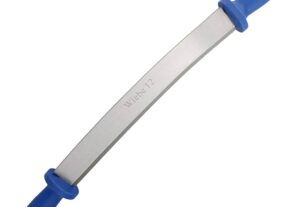If you’re in the business of bomb disposal, then you know that having the right EOD tools can mean the difference between life and death. From robots to disruptors, there are a variety of tools available to help bomb squads do their job safely and effectively. In this ultimate guide, we’ll take a closer look at the world of EOD tools and explore what makes them so essential.
What Are EOD Tools?
EOD stands for Explosive Ordnance Disposal, which is a term used to describe the process of identifying, disarming, and disposing of explosive devices. EOD tools are the equipment and gear used by bomb disposal experts to carry out their work.
There are many different types of EOD tools available, each designed for specific tasks. Some of the most common types of EOD tools include:
1. Robots: Remote-controlled robots are often used to approach and examine suspicious packages or devices. They can also be used to transport explosives safely away from populated areas for controlled detonation.
2. X-ray machines: Specialized x-ray machines can provide detailed images of suspicious packages or devices without physically touching them.
3. Disruptors: These devices are used to safely detonate explosives from a distance, minimizing risk to personnel.
4. Protective gear: Bomb disposal experts must wear specialized protective gear such as helmets, suits, and gloves to protect themselves from potential explosive blasts.
5. Chemical testing kits: These kits allow bomb disposal experts to identify any chemicals present in a device or package, helping them determine an appropriate course of action.
6. Portable bomb suppression blankets: These blankets can be deployed over an explosive device to contain any potential blast.
Why Are EOD Tools So Important?
EOD tools are essential because they allow bomb disposal experts to carry out their work safely and effectively. Without these tools, bomb disposal experts would be forced to approach potentially explosive devices without any protective gear or specialized equipment, risking their lives and the lives of others.
EOD tools also help minimize the risk of accidental explosions. By using robots, x-ray machines, and other specialized equipment to examine and disarm explosive devices, bomb disposal experts can reduce the chance of an unintentional detonation.
Additionally, EOD tools allow bomb disposal experts to dispose of explosives in a controlled manner. By using disruptors and other specialized equipment, they can safely detonate explosives from a distance, minimizing any potential damage or harm.
Types of EOD Tools
There are many different types of EOD tools available, each designed for specific tasks. Here are some of the most common types of EOD tools:
1. Robots
Robots are often used by bomb disposal experts to approach and examine suspicious packages or devices. They can also be used to transport explosives safely away from populated areas for controlled detonation.
One example of a robot used for EOD purposes is the TALON® robot. This remote-controlled robot is equipped with cameras, sensors, and manipulator arms that allow it to approach and examine suspicious packages or devices.
2. X-ray Machines
Specialized x-ray machines can provide detailed images of suspicious packages or devices without physically touching them. This allows bomb disposal experts to determine whether or not an object contains explosives before attempting to disarm it.
One example of an x-ray machine used for EOD purposes is the MINI Z® handheld scanner. This portable device uses x-rays to create high-resolution images of suspicious objects in real-time.
3. Disruptors
Disruptors are devices used to safely detonate explosives from a distance, minimizing risk to personnel. These devices use shaped charges to destroy explosive devices while minimizing any potential damage or harm.
One example of a disruptor used for EOD purposes is the RE70™ disruptor. This device is capable of destroying explosive devices up to 100 meters away, making it ideal for use in urban environments.
4. Protective Gear
Bomb disposal experts must wear specialized protective gear such as helmets, suits, and gloves to protect themselves from potential explosive blasts. This gear is designed to minimize the impact of any blast and protect against shrapnel and other debris.
One example of protective gear used by bomb disposal experts is the Demining Helmet DH-3. This helmet features a lightweight design with an adjustable chin strap, providing both comfort and protection.
5. Chemical Testing Kits
Chemical testing kits allow bomb disposal experts to identify any chemicals present in a device or package, helping them determine an appropriate course of action. These kits are essential for ensuring the safe handling and disposal of explosive materials.
One example of a chemical testing kit used for EOD purposes is the HazMatID Elite™ handheld analyzer. This device can quickly identify hazardous materials and explosives using advanced spectroscopy technology.
6. Portable Bomb Suppression Blankets
Portable bomb suppression blankets can be deployed over an explosive device to contain any potential blast. These blankets are made from high-strength materials that can withstand the force of an explosion and prevent shrapnel and other debris from flying outwards.
One example of a portable bomb suppression blanket used for EOD purposes is the TAC-700® bomb blanket. This blanket features multiple layers of high-strength material that can absorb and contain the force of an explosion, protecting nearby personnel and structures.
Conclusion
EOD tools are essential for ensuring the safety of bomb disposal experts and minimizing the risk of accidental explosions. From robots to x-ray machines, there are many different types of EOD tools available, each designed for specific tasks.
By using these specialized tools, bomb disposal experts can safely approach and examine suspicious packages or devices, identify any hazardous materials present, and dispose of explosives in a controlled manner. This allows them to carry out their work safely and effectively, minimizing the risk of harm to themselves and others.
References:
1. https://www.army.mil/article/230006/explosive_ordnance_disposal_technology_keeps_soldiers_safe
2. https://www.defensenews.com/smr/national-defense-magazine/2020/09/30/how-robots-and-autonomous-systems-are-changing-eod-operations/
3. https://www.bombdisposal.com/bomb-disposal-equipment/
4. https://www.tssi-ops.com/eod-breaching-tools.html
5. https://www.policeone.com/police-products/tactical/breaching/articles/portable-bomb-suppression-blankets-for-use-by-public-safety-agencies-Tw1PcJNlLZf2Gx9Q/




